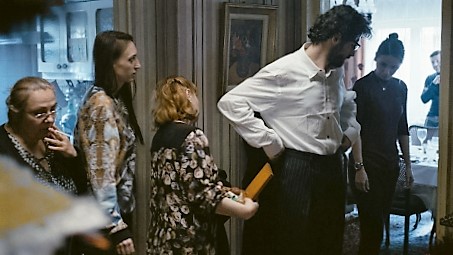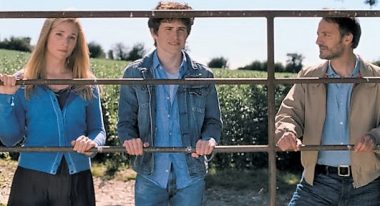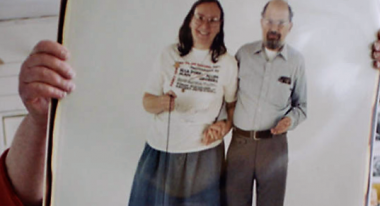 Back to selection
Back to selection
True Crit
Weekly film reviews. by Howard Feinstein
Makeovers: The New York Film Festival, Part II
 Sieranevada
Sieranevada Every film not only tells a story but is a story. Lumping several movies together to find commonality is a perilous pursuit. For example, we have to determine if shared traits operate at the level of content, plot or characters. Or might they be more in the vein of form — style, perhaps, or generic membership?
Last week, zeroing in on what I consider the six finest features screening in the first third of the New York Film Festival led me to a marked thematic thread, which we can file under “loneliness and the attempt to escape it.” From the subject arise multiple possibilities for expression. In theory, the relationship is more symbiotic, but it is never equal. One leads.
Surveying the mid-section of the event yields additional superior films, the titles of which I have listed below, outside of hierarchies. (Flagged: Those in sidebars, i.e., not anointed Main Slaters, or the rare Main Slaters without distribution.) Here, form rules the roost. The most obvious similarity among them is revisionism, the reworking of an essential component ranging from genre to the character of one’s previous efforts. Radiating from these structural concerns are relevant themes, which might occupy secondary positions but are nevertheless formidable partners in the recalibration process. In the group reviewed here, the most obvious are persistence and obsession, not unexpected given the degree of expertise and focus required to reconstruct away from earlier models.
Sieranevada (Cristi Puiu, Romania)
NO DISTRIBUTOR
Puiu (The Death of Mr. Lazarescu) redirects and amplifies conventional set-ups in this inclusive extended-family drama. The film is set almost totally indoors, in a tchotchke-filled, Communist-era apartment on the outskirts of Bucharest during a Romanian wake for a man whose widow, Nasu (Dana Dogaru), hosts dinner and a religious service, the latter timed to be at the end of the 40 days it takes for the departed to meet God and stand in judgment. The ritual is meant to be led by their Orthodox priest, a man in gold robes with a thick white beard, but he and his young vicars keep getting delayed. By the time he arrives, he has already become a Godot surrogate for several rooms full of hungry, plowed relatives at one another’s throats. The scenario is Bunuelian, whether or not it’s a conscious homage.
We enter the cramped quarters at the invitation of a laid-back, middle-aged doctor, Lary (Mimi Branescu), Nasu’s older son, and his know-it-all second wife, Laura (Catalina Moga). Amidst the scattered squabblers, the pair become appreciated gatekeepers for potentially overwhelmed spectators, even if they upstage the disciplined ensemble with their petty bickering. On the other hand, the disagreements they have outdoors, in the car and on the sidewalk, bracket the film, providing a bit of relief from the claustrophobic mood. The price is high: overexposure to irritating, unnecessary aggression. Family is, after all, frequently the site of deferred negativity. Who else can you count on to be so forgiving (if not forgetting)?
Puiu and DP Barba Balasoiu shoot not from a character’s eye level but according to vague eyelines that run from the apartment’s tiny central foyer into different rooms. Doors open and close in synch with encounters and specific dialogue that are commandeered by an exacting screenplay. Given the occasional overlap, they sometimes become layered, albeit neatly; at other times, they take place in isolation and are distinctive. Sometimes the men film from a height that approximates eye level, enabling them to take in additional family members, each with their own story, from different rooms, as well as the ongoing cacophony. The point-of-view turns out, daringly, to be that of the dead man, more eye of God than human. The camera moves up, down, and sideways, dips and rises when necessary, in order to register the changing placement.
In the cramped quarters overflowing with visitors, there is never a dull moment. Situations and conversations don’t suddenly stop. They are ongoing, if interrupted, characterized by impressive fluidity and democracy. Everyone is heard, everyone gets their screen time. Some interesting eccentrics are part of the spectacle, and much of the time their differences turn into valid, even affectionate, dialectical arguments. At other times, they do not. The idealistic old aunt, a proud Communist and anti-monarchist in a fur hat, gets into a heated exchange with Lary’s relatively progressive sister about her dated political affiliation, but then, just when we might consider relaxing and accepting her position, she begins to denigrate “kikes like Marx and Lenin” and “blacks—Africans, not gypsies.” Also on hand are a conspiracy-theorist cousin, a philandering great-uncle, and a drunken young Croatian woman who is the guest of a punk cousin. Perhaps the most sympathetic of all is Lary’s brother, who must, following custom, get through all of this enveloped in his late father’s grotesquely oversized suit.

Son of Joseph (Eugene Green, France/Belgium)
In some ways, Green’s aesthetic is… ascetic. It sucks the energy out of some elements in a film, but the sacrifice provokes an excess that might be available to others. Balance is the game. The theater vet fuses baroque stagecraft with cinema like no one else. It’s all proudly mannered.
For starters, as anyone who saw La Sapienza knows, his actors declaim, speaking without inflection. They are in some ways as much décor as people; in fact, the décor itself is dealt with similarly. Both are minimalist, throwing attention to exceptions: for dialogue, the quips of literary dandy Oscar (Mathieu Amalric) and the loony monologues of pretentious book critic Violette (Maria de Medeiros); for art, the breathtaking madrigal music, reinterpretations of 16th– and 17th-century works featuring the moving lament of a mother over her child’s grave, performed by Le Poeme Harmonique; and for props, compared to the spartan bedroom of deeply angry 15-year-old protagonist Vincent (Victor Ezenfis), the pretentious hotel-office furniture of his as-yet unrecognized father, Oscar.
In his sleeping space is a huge reproduction of Caravaggio’s masterful “Sacrifice of Isaac,” which the boy can not stop staring at. Here sacrifice means abandonment, and Vincent will not let go of the shame that, according to his single mother, Marie (Natacha Regnier), he has no father.
The film morphs from the tale of a bored schoolboy who, with a friend, tortures a large rat, to the anxious pursuit of the truth about his paternity. Not only Vincent is key to the quest: So is Joseph (Green regular Fabrizio Rongione), a reformed villain who has turned to ethics, and, set up to seem a result of chance, the estranged brother of poseur Oscar. The bible says that Joseph became a father through his son; you can follow the complications from there. Let’s leave it at this: Green spins the Nativity. A funny man, he throws in for the sake of levity humorous scenes with a donkey (political) and a couch (sexual).
Most impressive of all of Green’s reworkings of film is his consistent deployment of the intense close-up, an oblique visual analog to the flattened speech patterns. DP Raphael O’Byrne bathes in light these glorious images. Characters posed symmetrically look straight ahead when they speak, as if talking into the air.

Fire at Sea (Gianfranco Rosi, Italy/France)
Documentarian Rosi was confronted with a dilemma: How to make a doc novel enough to engage audiences about a subject covered so often in the 24-hour news cycle that interest has waned to very little? Such is the status of the migrant crisis in Europe. More shocking, and thus more challenging, is that the suffering refugees have been denied their humanity by the Europeans and become mere abstractions.
You can hear or read about thousands of desperate migrants who start out in tight, unsafe quarters only to drown during the perilous journey, or, for those who do manage to reach their destination, to be stuck in substandard detention centers followed by indignities of bureaucratic procedure and the uncertainties of relocation. It is easy to become numb to numbers. You need a touching photograph of a dead child sprawled out on a beach — alone.
Rosi’s solution is to reverse some otherwise unquestioned conventions of docmaking. He shoots on the extreme southern Italian island of Lampedusa, a small place whose population of 6,000 is so insular that the inhabitants are barely cognizant of the temporary visitors, and definitely disengaged from their plight. (The authorities ghettoize the migrants.) To make his point, Rosi juggles the givens of outsider and insider, observer and subject, neither simply or predictably.
To work up to his own direct encounters with the migrants — in this structured film, we have at the beginning only a suggestion of their existence through radio messages picked up by the coast guard, before we get more of a real sense of them halfway through — he focuses on an awkward but engaging and extroverted local adolescent, Samuele. The youth’s problems — a lazy eye that affects his archery, a propensity for seasickness, truly a stigma for the son of a fisherman — are minor compared to those of the wanderers who risk everything to cross the ocean, but for him, they are indeed serious.
Rosi stacks the deck. When we meet Samuele, he is at the home of his grandmother, who cooks in committed Italian fashion — an example of the basics that he takes for granted. Even against a backdrop of iffy boats approaching with malnourished human cargo, the sedentary boy occupies the place of the observed, more an insider than an outsider. The migrants may be undifferentiated, but they are more mobile than Samuele, less the observed than a new strain of observer particular to our era.
During the year he spent on Lampedusa, the crafty Rosi secured permission to accompany naval personnel and a charitable organization in rescue operations, and to film inside the stark no-man’s land of a detention center. He shares his experiences with us through a surrogate, Dr. Pietro Bartolo, the only physician on the island, whose job requires checking out new arrivals to assess their physical condition and the best (!) place to put them. By default, he is a witness: The data he collects is always visible on his computer screen. He makes a choice as well: He becomes a participant. In order to aid the dispossessed refugees, he trespasses, darting between two worlds that are in close proximity but almost totally disconnected.
The same applies to Rosi. By filming the lives of both the boy, an unknowing innocent, and his opposite, an experienced professional and humanist who bears the burden of knowing too much, the documentarian appears to be on to something possibly inherent in the human condition but generally unavailable even to the most curious. It can be felt and, perhaps in one of God’s mysterious ways, deflected in the case at hand on to these as-yet-unidentified phantoms, granting them a tad of dignity. Both Samuele and Dr. Bartolo become catalysts for an emotional contract struck between the spectator and the anonymous voyagers.

The B-Side: Elsa Dorfman’s Portrait Photography (Errol Morris, US)
SPOTLIGHT ON DOCUMENTARY
In the two films that follow, the directors’ goals do not involve revamping some accepted convention within the general cinematic vocabulary; no, they are specifically aimed at their own prior outlay. Take, for example, the concept of genre. It implies repetition of previous successes, with audience familiarity theoretically guaranteeing added profit. Whatever the economic basis, the generic has adopted social, political, and, primarily, aesthetic overtones. Sometimes, however, a filmmaker might go up against the grain accepted earlier, or maybe just put it aside — like nipping the greenlighting of a romantic comedy in the bud in order to go for grand guignol.
Now, remove genre. The subject here is shifting gears, with one’s previous efforts a template to be defied, bent, or discarded. This touches on motivation behind new works by American docmaker Errol Morris (The B-Side: Elsa Dorfman’s Portrait Photography) and Kleber Mendonca Filho (Aquarius), from Brazil. A shared element that runs through most of their earlier work is a constant presence, a common denominator, which might be ideological, generic, thematic, or formal. The directors stray. To good effect, methinks.
Morris followed a much more rigorous methodology in films like Standard Operating Procedure and The Thin Blue Line. Their self-reflexive nature called attention to the work while he approached some sort of resolution. He always imposed his idea for the appropriate form for a particular subject.
In The B-Side, Morris deconstructs, then reconstructs. A motion picture combines image, sound, and narrative, or, expressed differently, visuals, soundtrack, and storyline. This documentary is a labor of love. The subject is an elderly photographer and old friend of Morris who specializes in intimate portraits shot and developed by means of equipment inside a huge, self-contained box, one of five manufactured by hand according to the specifications of Edwin Land of the Polaroid Corporation. Dorfman had been on the fringe of a group of artists who had a professional relationship with Polaroid; Land felt that they were good for the company.
The title refers to the second of two pictures she makes of a person, which, taken together, add up to an unplanned catalog of her work. It’s odd to use the gallery term catalog, because she considers herself less an artist than a small businessperson who, hustling to insure survival in her field, generates awareness of, and interest in, a technique of self-duplication that she obviously adores. Made individually and peeled apart after 75 seconds of exposure to a podful of chemicals, the pictures are vertical, the standard size 20” x 24”.
For the soundtrack, Morris commissioned composer Paul Leonard-Morgan, recognized for his fusion of classical music and electronica. This leaves narrative. That becomes a mix of her observations and descriptions, as well as the anecdotes and reminiscences she shares on camera with Beat poet Allen Ginsberg, a close friend dating back to their days at New York’s Grove Press.
Her commentary combines detailed notations about old projects decades after the fact crossed with yenta-like gossip and personal assessment. She speaks while rifling through the pictures, many of which have been gathering dust in the ubiquitous file drawers in her secluded studio located behind the family house. Ginsberg and his lover, Peter Orlovsky, were two of the original 20” x 24” subjects she took on after exiting New York and its poetry scene and patiently redoing herself in her hometown of Boston.
What makes the gestalt unique is the freshness of her take on people, and life in general, an almost childlike innocence which is evident in the way she treats both the people close to her as well as the subjects of a shoot. It takes great pleasure, indeed great comfort, in the ordinary. Morris’s track record, on the other hand, is studded with encounters with objects of his fascination: the extraordinary. I fantasize that their respective endgames could meet head-on in a metaphoric creative pool in which both their voices could be heard simultaneously — a function of friendship, respect, and maybe a dose of magic.
Dorfman does not try, nor does she desire, to steer photography in a mystical direction to pursue a subject’s soul. She says she connects with surfaces, with their veneer. Any penetration is unnecessary.
Morris might as well have left at home his trademark Interrotron camera which he uses to ease a subject’s anxiety, and enable a direct eyeline with the viewer, by simulating a face-to-face interview. In spite of the fact that it has a soothing function, mediation with an open book like Dorfman invites obstruction, at least according to a colleague. When she dons the director’s hat, her directness and openness relax her subjects, even nudging them in the direction of Japanese sonomama, an attentive, blissful, and natural state that serves as her own unclogged Point Zero.
Once Morris understood that her basic technique was appropriate for a film about her and her artistic sensibility, he borrowed from her typical methodology, which comes across as antiquated until you see the pictures made inside a bulky machine that could pass for a setpiece in The Wizard of Oz. This heimishe, 78-year-old Jewish woman manages to maintain her authority even when the means of production changes hands, and the recipient is none other than a powerhouse like Errol Morris. She leads, he follows.

Aquarius (Kleber Mendonca Filho, Brazil/France)
In Neighboring Sounds, Mendonca’s tweaks of conventions of moviemaking reveal an inventiveness in his mise-en-scene and montage, and even more so on the eclectic soundtrack. Some of his major characters get, uh, tweaked in the story itself by tough guys informally hired by wealthy co-op owners so frightened that they are willing to pay for protection inside a single tall building on one block of a gated high-rise community. (A neighborhood resembling a slum is nearby.)
With Aquarius, Mendonca does not rush further into experimental filmmaking; in fact, he takes things down a few notches. The movie is more of a beautifully constructed and finely acted character study, which focuses largely on Sonia Braga’s gorgeous 60-year-old widow, Clara. We witness what she does in private, such as engaging a hustler to ease the pain of loneliness, discussing with her pals her botched mastectomy and its effect on her love life, and fighting with her spoiled ingrate of a daughter. The film sounds like more than what is sometimes called an old-age drama.
In lieu of avant-garde flourishes, Mendonca creates a smoother, more accessible movie than Neighboring Sounds. We could also call it a building study. Once again, a residential edifice sits on the front lines of a battle between a tenant and shameless money men. Although it has known better days, the structure is a charming remnant and, more promising, a four-story walk-up right on the beach.
Clara is the last remaining tenant in the Aquarius. Everyone else took a buyout, and she is under intense pressure to do the same. She is up against a successful but slimy father-son development team whose pride in their work is measured in cycles of construction and renovation. An intense lover of music, the former critic rates her memories, and her children’s, more highly than a quick payoff.
Clara gets useful advice from friends who practice law, and moral support from a makeshift squad of locals she has come to know over the years in her friendly neighborhood. A wild, wonderful, and hilarious sequence in a restaurant illustrates the secret-club-manner in which women band together to support a girlfriend in distress. The toll the legal battle takes on her enables acquaintances to fiercely empathize; presumably, the dynamic operates in similar fashion around the local movie house.
Watching Aquarius yanked from my memory bank an exhausted line, perhaps an irrelevant one, that has been borrowed from one medium and stretched to land on the fundamental metaphor underlying another. Reduced to essentials, architecture is nothing so much as frozen music.
